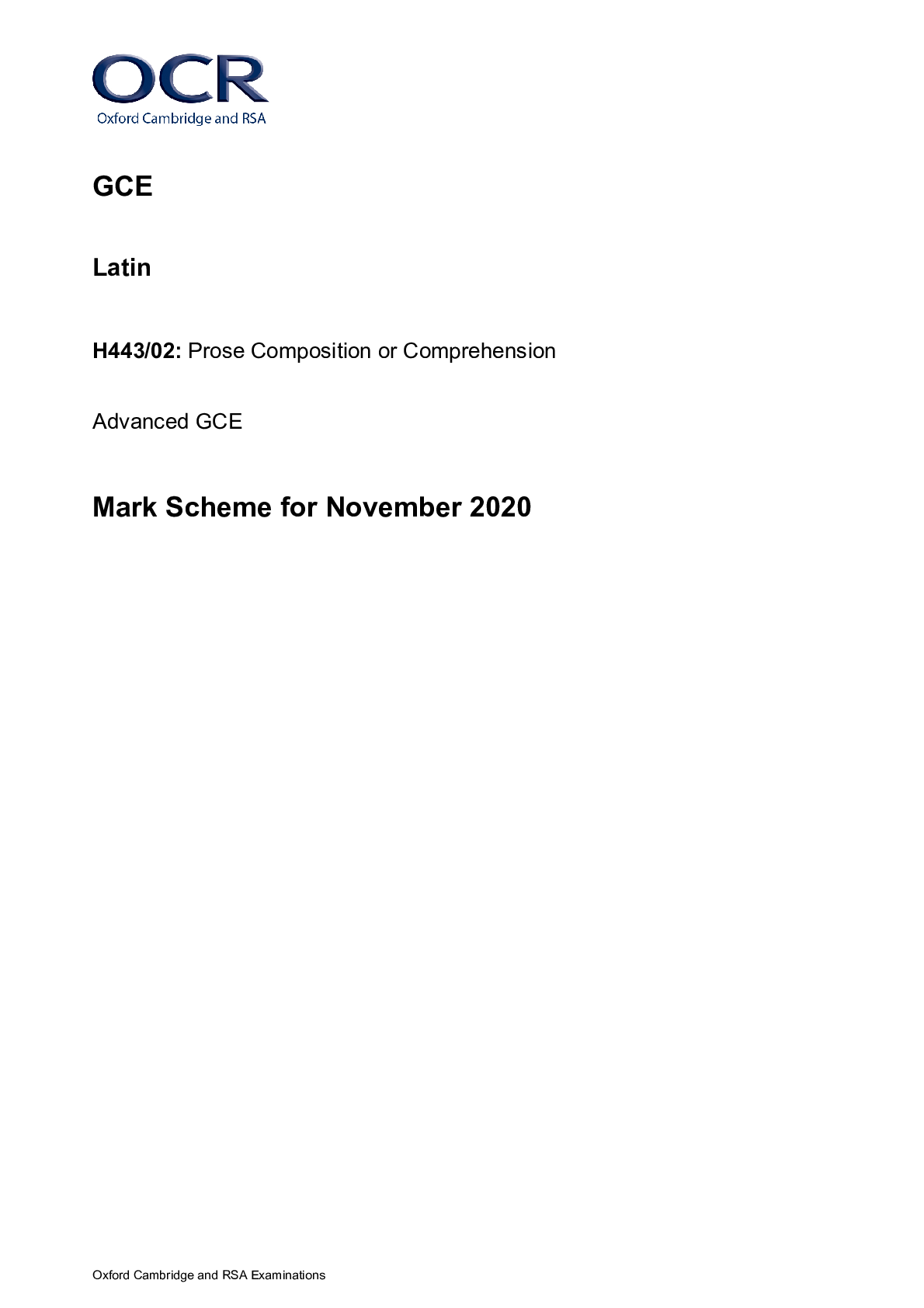Greek > GCSE MARK SCHEME > GCSE (9–1) Classical Greek J292/06: Literature and Culture General Certificate of Secondary Educat (All)
GCSE (9–1) Classical Greek J292/06: Literature and Culture General Certificate of Secondary Education Mark Scheme for November 2020
Document Content and Description Below
GCSE (9–1) Classical Greek J292/06: Literature and Culture General Certificate of Secondary Education Mark Scheme for November 2020 Oxford Cambridge and RSA Examinations GCSE (9–1) Classi... cal Greek J292/06: Literature and Culture General Certificate of Secondary Education Mark Scheme for November 2020Oxford Cambridge and RSA Examinations OCR (Oxford Cambridge and RSA) is a leading UK awarding body, providing a wide range of qualifications to meet the needs of candidates of all ages and abilities. OCR qualifications include AS/A Levels, Diplomas, GCSEs, Cambridge Nationals, Cambridge Technicals, Functional Skills, Key Skills, Entry Level qualifications, NVQs and vocational qualifications in areas such as IT, business, languages, teaching/training, administration and secretarial skills. It is also responsible for developing new specifications to meet national requirements and the needs of students and teachers. OCR is a not-for-profit organisation; any surplus made is invested back into the establishment to help towards the development of qualifications and support, which keep pace with the changing needs of today’s society. This mark scheme is published as an aid to teachers and students, to indicate the requirements of the examination. It shows the basis on which marks were awarded by examiners. It does not indicate the details of the discussions which took place at an examiners’ meeting before marking commenced. All examiners are instructed that alternative correct answers and unexpected approaches in candidates’ scripts must be given marks that fairly reflect the relevant knowledge and skills demonstrated. Mark schemes should be read in conjunction with the published question papers and the report on the examination. © OCR 2020J292/06 Mark Scheme November 2020 2 Annotations Annotation Meaning Blank Page – this annotation must be used on all blank pages within an answer booklet (structured or unstructured) and on each page of an additional object where there is no candidate response. Good response/positive Unclear/dubious point Benefit of doubt Consequential error Incorrect translation or interpretation or factual error Major error Minor error / SPAG Harmful addition Good use of Greek / valid stylistic point Omission mark highlight Harmless addition Blank Page – this annotation must be used on all blank pages within an answer booklet (structured or unstructured) and on each page of an additional object where there is no candidate response. Good response/positive Good style point Weak style pointJ292/06 Mark Scheme November 2020 3 12. Subject Specific Marking Instructions Guidance on applying the marking grids for the 6-mark extended response This question focuses on candidates’ selecting examples from the ancient source material which has been included the Question Paper Insert and expressing conclusions based on the selected examples in relation to the question posed. Therefore candidates will be assessed on the quality of the points made and the range and quality of the examples they have selected. The expectation is that candidates will base their answer solely on the material they can glean from the source material provided. Level Marks Description 4 5–6 • very good engagement with the question • draws and expresses a range of relevant points, with development, based on a range of well selected aspects from the stimulus material, with well thought out discussion 3 3–4 • good engagement with the question • draws and expresses sound points, with some development, based on a range of well selected aspects from the stimulus material, with sound discussion 2 2 • some engagement with the question • draws and expresses some points based on a rather limited range of aspects from the stimulus material, with some discussion 1 1 • little or no engagement with the question • draws and expresses points which are of little relevance and are supported with little evidence from the stimulus materialJ292/06 Mark Scheme November 2020 4 Guidance on applying the marking grids for the 8-mark extended response Two Assessment Objectives are being assessed in this question – AO2 (Demonstrate knowledge and understanding of ancient sources) and AO3 (Analyse, evaluate and respond to ancient sources). The two Assessment Objectives are equally weighted. Examiner must use a best fit approach to the marking grid. Where there are both strengths and weaknesses in a particular response, particularly imbalanced responses in terms of the assessment objectives, examiners should carefully consider which level is the best fit for the performance overall. For example, you should not be able to achieve a mark of 6 made up of AO2 = 5 and AO3 = 1. Marks for AO2 should be rewarded for the detail and accuracy of the knowledge of the ancient sources they deploy in their answer and the candidate’s understanding of these ancient sources, including their interpretation and an understanding of their limitations. Marks for AO3 should be awarded for how well the response is addressing the question / argued, for candidates selecting relevant examples from the ancient sources they have studied and drawing and expressing conclusions based on the selected examples in relation to the question posed. Candidates will be assessed on the quality of the conclusions and points they make and the range and quality of the examples they have selected 8-mark grid for the extended response question AO2 = 4 marks = Demonstrate knowledge and understanding of ancient sources AO3 = 4 marks = Analyse, evaluate and respond to ancient sources Level Marks Description 4 7–8 detailed knowledge with good interpretations of the ancient sources and a good understanding of their limitations (AO2) well-argued response to the question which is supported by a range of well-selected examples (AO3) The response is logically structured, with a well-developed, coherent line of reasoning. 3 5–6 some knowledge and with some interpretations of the ancient sources and some understanding of their limitations (AO2) a good response to the question which is supported by a range of relevant examples (AO3) The response is well structured with a clear line of reasoning. 2 3–4 limited knowledge and with limited interpretations of the ancient sources and limited understanding of their limitations (AO2) a reasonable response to the question which is supported by a few relevant examples (AO3) The response presents a line of reasoning which is mostly relevant but may lack structure. 1 1–2 very limited knowledge with very little or no interpretation of the sources or understanding of their limitations (AO2) a very limited response to the question with very limited reference to the ancient sources (AO3)J292/06 Mark Scheme November 2020 5 The information is communicated in an unstructured way. 0 = No response or no response worthy of credit.J292/06 Mark Scheme November 2020 6 Guidance on applying the marking grids for the 12-mark extended response Two Assessment Objectives are being assessed in this question – AO2 (Demonstrate knowledge and understanding of ancient sources) and AO3 (Analyse, evaluate and respond to ancient sources). The two Assessment Objectives are equally weighted. Examiner must use a best fit approach to the marking grid. Where there are both strengths and weaknesses in a particular response, particularly imbalanced responses in terms of the assessment objectives, examiners should carefully consider which level is the best fit for the performance overall. For example, you should not be able to achieve a mark of 10 made up of AO2 = 8 and AO3 = 2. Marks for AO2 should be rewarded for the detail and accuracy of the knowledge of the ancient sources they deploy in their answer and the candidate’s understanding of these ancient sources, including their interpretation and an understanding of their limitations. Knowledge of the modern world does not count towards AO2, but may be used to support and explain arguments for AO3. Marks for AO3 should be awarded for how well the response is addressing the question / argued, for candidates selecting relevant examples from the ancient sources they have studied and drawing and expressing conclusions based on the selected examples in relation to the question posed. Candidates will be assessed on the quality of the conclusions and points they make and the range and quality of the examples they have selected. 12-mark grid for the extended response question AO2 = 6 marks = Demonstrate knowledge and understanding of ancient sources AO3 = 6 marks = Analyse, evaluate and respond to ancient sources Level Marks Description 4 10–12 detailed knowledge with good interpretations of the ancient sources and a good understanding of their limitations (AO2) well-argued response to the question which is supported by a range of well-selected examples (AO3) The response is logically structured, with a well-developed, coherent line of reasoning. 3 7–9 some knowledge and with some interpretations of the ancient sources and some understanding of their limitations (AO2) a good response to the question which is supported by a range of relevant examples (AO3) The response is well structured with a clear line of reasoning. 2 4–6 limited knowledge and with limited interpretations of the ancient sources and limited understanding of their limitations (AO2) a reasonable response to the question which is supported by a few relevant examples (AO3) The response presents a line of reasoning which is mostly relevant but may lack structure 1 1-3 • very limited knowledge with very little or no interpretation of the sources or understanding of their limitations (AO2) • a very limited response to the question with very limited reference to the ancient sources (AO3)J292/06 Mark Scheme November 2020 7 The information is communicated in an unstructured way. Question Answer Mark Guidance 1 • A water clock (klepsydra) worked like an egg-timer • It was used to time the speeches made by individual speakers • Water from the upper pot flowed into the lower pot • When the upper pot was empty, the speaker’s time was up AO2 1 Any one clear point 2 A person could participate in the law courts provided that they were • Male • An Athenian citizen • Over 30 years of age AO2 2 Allow reference to being selected by the kleroterion Do not allow reference to ‘age of consent’ or ‘age of majority’ as this was not 30 yrs 3 Payment was crucial as it enabled even the poorest citizens to participate The pay provided was the equivalent to the minimum worker’s daily wage Payment allowed working citizens to be compensated for missing a day’s work on their farms or businesses AO2 2 4 There were more poor uneducated citizens than rich educated ones, so the wealthy would be outnumbered which was unpopular with them Democracy was seen as ‘mob rule’ The source shows a contrast between the noble characteristics of oligarchy (birth, wealth & education) and the baser characteristics of democracy (low birth, poverty, lowly employment), suggesting that oligarchy is preferable Athenian democracy only accepted the voices of citizen men and ignored those of women, metics and slaves AO2 2 Accept any two reasonable pointsJ292/06 Mark Scheme November 2020 8 Democracy would force the wealthy elite to lose much of their power 5 Assess against criteria in the 6-mark AO3 grid Pathos ‘in our old age we are not looked after by you in a manner worthy of the sea-battles we fought but we suffer dreadfully…’ • Old are being let down by the young - this goes against the traditional Greek values whereby a child was expected to protect and care for his/her parents in their old age • Former Athenian war heroes are now forgotten / abused (cf later references to the emotive Battle of Marathon) • Contrast between the past heroism and present status as victims • Use of ‘we’ – it’s not just applying to this particular old man • Ripped off by the courts so that his money is wasted on fines when he had intended it for his coffin – particularly graphic; neither option is a pleasant way of spending money Image of old man as victim of young orator You allow us old folks to be taken to court and laughed at by smart young orators • Contrast between old and young, weak & befuddled vs strong & arrogant • Old men described as ‘nonentities, tongue-tied and played out’ • Visual image of elderly men relying on their walking sticks • Sense of confusion & pathos stressed by reference to ‘fog & mumbling’ • Contrast between inarticulate old man and sharp-tongued young orator: image is easy to picture • Aggression implied by ‘strikes quickly’ (like a snake) • Metaphor of being ‘tied up with epigrams’ and clever sophistry; ‘traps & pitfalls…confusing…tearing him to shreds… destroy over the water-clock’ Sense of unjust humiliation: AO3 6 Candidates cannot access Level 4 marks if they do not include discussion of the writer’s use of language and include quotations from the textJ292/06 Mark Scheme November 2020 9 • Young orator metaphorically takes him by the scruff of the neck (like a weak young animal) • Describing the old man as being a Tithonus (mythical elderly lover of Eos who granted him immortality but forgot to give him eternal youth so he grew older and older) makes him a figure of fun & derision • Image of elderly men confused by the process of the law contrasts with Aristophanes’ portrayal of the elderly Procleon in ‘The Wasps’ who cannot wait to get to the courts each morning to act as a juror • Outraged expressed in final section of the source – potentially addressing the audience • Sense that traditional values have been eroded • Contrast between the current old man and his brave younger self ‘a man who bore his share of toil, and wiped the hot manly sweat in plenty off his brow…’ • Sense of injustice: here is a man who fought for Athens and is now being publicly ridiculed Question Answer Mark Guidance 6 Candidates can fully agree or disagree, or discuss the merits of both arguments Yes, the processes of democracy were well-organised • The water clock in Source A suggests that speeches were timed to ensure equality • Source B shows that there was payment: ‘The next characteristic of democracy is payment for services; assembly, law courts, magistrates, everybody receives pay…’ to ensure equality and enable anyone eligible to take part • Source C indicates that if convicted, people faced fines which would act as a deterrent, and would go into the public coffers 8 made up of AO2 = 4& AO3 = 4 An AO-heavy response may focus on details from the ancient sources but not draw many valid conclusions. This is likely to limit the level at which this work can be rewarded.J292/06 Mark Scheme November 2020 10 • Source 3(i) shows Theseus saying ‘The people are sovereign, in annual rota by turns’ which shows that the processes were intended to be as fair as possible • Source 3(ii) mentions the ‘red rope’ – a means by which members of the Ekklesia would be herded into the Pnyx area as promptly as possible • Source 3(iii) shows that the electorate were divided into clear groups that were randomly grouped together by lot ‘in such a way that each tribe should have a share in every region’ • Source 3(iv) indicates that the agenda for the people to discuss at the Ekklesia was drawn up by the Boule ‘so that they can be effective…’; Source 3(iii) had mentioned that the Boule had been made bigger, probably to manage the growing administrative needs of the Ekklesia • Source 3(v) shows a Kleroterion, a machine which randomly allocated jurors to courts to avoid corruption & bribery No, the processes of democracy were not well-organised • Source B suggests that the majority of people involved in the democratic process were low-born: ‘whereas oligarchy is characterised by birth, wealth and education, the notes of democracy appear to be the opposite of these – low birth, poverty, mean employment.’ • Source C shows an old man being tricked by a slick young speaker in the law courts, suggesting that justice was not always served in the law courts – clever oratory could be used to tie the opposition into knots; it is unclear in the extract whether the pathetic old man is genuinely guilty but he certainly gets convicted and fined • Another source (3(i)) suggests that this was akin to ‘mob-rule’, where the poorly-educated masses would be easily persuaded by clever rhetoric • The herald in 3(i) talks about the working man having little time to consider the ‘common interest’, indicating that decisions would be made by the electorate with little understanding of the situation or potential impactJ292/06 Mark Scheme November 2020 11 • Source 3(ii) indicates that the sheer number of people involved could make the democratic process chaotic: the start of the Ekklesia meeting is delayed, there is reference to rowdy behaviour: ‘…they’ll come jostling each other for the front row like nobody’s business, flooding down in throngs…’; ‘…I have come quite prepared to shout and interrupt and slang the speakers …’ 7 Evidence of rewards from Source D • Glory and fame throughout the ancient world ‘beloved and admired by the whole world..’ • Victors brought prestige to their cities as well as their own families ‘not only the athletes were objects of envy but that also the cities of the victors became renowned…’ • Being seen to contribute to the Olympic Games brought glory not simply for one’s city but from the whole of Greece: ‘expenditures in the Olympian Festival, however, enhance the city’s reputation throughout all Greece…’ Rewards available to victors: • Olive wreath from sacred olive tree at Olympia • Red woollen fillet ribbons that they tied around their heads or arms • Having the athlete’s name recorded as a victor in Olympic records • Rewards given by their home town: free meals for life for the athlete and his family in the city hall • Poetry, hymns and odes would be written in their honour (Source C2(v)) • Ceremonial entrance to the city on their return from the Games • Statues of the athlete could be dedicated to the gods • Front seats at events such as the theatre AO2 4 Candidates should include clear references from Source D in their answer 8 • The event took place in the precinct sacred to Zeus & Hera where there were a number of temples & shrines AO2 2 Accept any 2J292/06 Mark Scheme November 2020 12 • The goddess of Victory, Nike, was worshipped by spectators and competitors alike • Oaths were sworn guaranteeing that there would be no cheating • Prayers and hymns were offered to the gods before all sporting events • Religious processions took place as part of the event • Altars were established around the site on which private and public offerings were made to the gods • All victory wreaths were kept on a sacred table in the Temple of Hera • The event included a huge public sacrifice to Zeus made up of 100 oxen, and the victims were sacrificed on the huge altar to Zeus (bomos) • Judges were sworn in with prayers and oaths 9 Ancient training is similar to modern Olympic Training: • Ancient and modern athletes need to maintain a highly structured lifestyle keeping to rules (‘exercise on a fixed schedule at definite hours…’) • Diet is strictly regulated and athletes must observe an alcohol ban (‘…keep away from desserts… not can you have a drink of wine whenever you want…’) • Ancient and modern athletes have coaches and are expected to do what they tell them (‘…you must hand yourself over to your coach exactly as you would to a doctor…’) • While training, athletes must show physical and mental resilience and learn to manage physical pain • Athletes are expected to be competitive ‘…in the contest itself you must gouge…’ • Athletes in any culture must accept that losing is part of the process (‘…and after all that there are times when you lose…’) Ancient training is not similar to modern Olympic training: • Nowadays athletes are encouraged to drink cold water AO3 3J292/06 Mark Scheme November 2020 13 • ‘…there are times when…you will be flogged’: modern athletes are not beaten either by their coach or by the umpires / marshals in modern sport 10 • It was spectacularly violent, but required consummate skill • Bouts could last a long time as there were no time limits • Pankration was a combat sport that was a combination of wrestling and boxing • Competitors tended to be extremely powerful and well-built, and the event required considerable stamina • There were virtually no rules • The only actions that were forbidden in the Olympic contest itself was biting and gouging, particularly of the eyes; however, the source makes it clear that these actions would go on as part of the training AO2 2 11 Assess against criteria in the 6-mark AO3 grid • The physical image of the god would have been awe-inspiring in terms of its sheer scale (13m / 43ft high) (Source C4(iii)) • Pausanias makes it clear that the scale was immaterial to the whole effect of the statue ‘..I know that the height and breadth of Olympic Zeus have been measured and recorded; but I shall not praise those who made the measurements, for even their records fall far short of the impression made by the sight of the image…’ • The expensive materials from which the statue was made would also impress a visitor: chryselephantine, ebony, jewels, a range of metals is used to decorate the god’s sceptre; even his sandals are wrought in gold; this would have been visually effective • Quality of the craftsmanship would have been impressive: sculpture, carvings (including an olive garland), embroidery, metal working, painting • Zeus’ figure is accompanied by other imposing figures: minor deities - Victories of different forms, an eagle and embroidered animals • The mythology surrounding the sculpting of the statue serves to add to its mystery – the god supposedly sent a thunderbolt to AO3 6 Accept any reasonable response with direct reference to the sourceJ292/06 Mark Scheme November 2020 14 signal his pleasure with the image; the mark on the temple floor from the thunderbolt strike is even covered with a vase made from expensive bronze rather than terracotta 12 ‘The ancient Greeks had a strong sense of justice and fairness.’ Access against criteria in the 12-mark essay grid Yes, the Greeks had a strong sense of justice and fairness Athenian Society • The water clock in Source A suggests that speeches in the courts were timed and speakers had the same amount of time in which to present their argument • Source B indicates that a political voice was given to the poor: they outnumbered the rich and as a result held greater power despite their lack of resources: money was not automatically the passport to legal or political success • Source B makes it clear that payment for playing a role in the democratic process was automatic, thus enabling those of reduced means to play a full part in the city’s legal and political life • Source C – even the elderly and uneducated were expected to participate in the legal system, and if found guilty would be liable to pay the penalty, irrespective of their past status (Source B3(x) points out ‘when it is a question of settling private disputes, everyone is equal before the law…’) • B1(iii) Pericles ensured the employment of a range of ‘unskilled masses’ in Athens by encouraging them to work on the Acropolis buildings – this was not simply a task for the wealthy or trained • Pericles’ sense of justice extends to arguing logically about how money from the Delian League should be spent ‘… all they supply is money…and this belongs not to the people who give it, but to those who receive it…’ 12 made up of AO2=6 & AO3=6 12 separate points are not required, provided that detail is given from the sources For higher levels, candidates should offer detail from specific sources Explanation of reference to sources: Topic B: Athenian Society Topic C: The Olympic Games Accept references to both topics or one Candidates that argue both sides of the question are likely to achieve higher marks in AO3 than ones who do not Reference to sources must be as detailed as possible; candidates are expected to use sources that are both in the Insert and others they have learnedJ292/06 Mark Scheme November 2020 15 • Rules were developed to enable any citizen over 18 years to be allowed to vote (with his deme’s acknowledgement) B2(ii) • Source B3(ii) shows that political decisions were made directly by a large number of citizens; B3(x) ‘…power is not in the hands of the minority but of the whole people…’ • Over years, the Athenian constitution was developed to include citizens from different parts of Athens – the city, the sea and inland areas so that they had an equal voice (B3(iii)) • Source B3(v) shows a kleroterion which was devised so that jurors would be randomly and fairly allocated to courts to reduce the chance of corruption • Ostracism was a reasonably fair and democratic means of temporarily ridding the city of a perceived threat (Sources B3(viii) & (ix)) without executing the individual or unduly punishing his family • Source B3(x) indicates that merit was given for ability not status: ‘when it is a question of putting one person before another in positions of responsibility, what counts is not membership of a particular class but the actual ability which the man possesses…’; poverty is not a reason to be kept in ‘political obscurity’ • Pericles’ funeral speech (B3(x)) stresses the Athenians’ respect for the law and significant pride in the city; he also refers to the citizens’ understanding of politics: ‘even those who are mostly occupied with their own business are extremely well-informed on general politics – this is a peculiarity of ours…’ Olympic Games • The rules and regulations of the Games in terms of management and umpires are highly detailed and related carefully by Pausanias (C1(ii) & C3(iv)) • Source E considers the punishing nature of training for the Olympics and makes it clear that only those who train hard and show significant mental and physical stamina are likely to win – thus their victory is well deservedJ292/06 Mark Scheme November 2020 16 • Source F shows the importance of victory in the cult of Olympian Zeus, suggesting that the training and exertion of the athletes is divinely approved • A truce was announced before the Games to enable athletes and spectators to prepare; the Greeks took the event so seriously that they suspended warfare as part of an agreed process with their enemies. Source C1(iii) shows the bronze discus inscribed with the terms of the truce. • Source C2(ii) discusses the way in which cheating at the Olympics was managed – Zanes were sacred to Olympian Zeus, stressing the importance of fair play; Source C4(i) shows the oaths that competitors, their relatives and coaches were expected to swear to Zeus; Source C4(i) indicates that the mere sight of images of Zeus (the ‘Oath God’) were enough to ‘strike terror into the hearts of sinners’ • Source C2(iii) shows that there were umpires in each event, and they are characterised by the stick they carry to control the competitors, ensuring good, fair practice • Source C2(iv) indicates that winning is very much supported by the gods – Victory is crowning a successful athlete with an olive wreath No, the Greeks did not have a strong sense of justice and equality Athenian Society • Source B suggests that pure democracy placed the emphasis too much on equality and not enough on education and talent; the poor masses outnumbered the wealthy, educated elite • Source C shows that the elderly could be duped by younger, quicker speakers in the law courts, and that past good behaviour would not protect a citizen from being punished by the law • Justice and fairness depend on an individual’s status in society: citizen men were treated with relative fairness, but theJ292/06 Mark Scheme November 2020 17 way in which the Greeks treated slaves and metics does not suggest a broad-minded view of human rights • The lives of slaves and women throughout the ancient Greek world were repressed and restricted, and they were seen as inferior to citizen men in all aspects of life • Source B2(ii) discusses the status of metics and the revenue they bring to Athens through the services they perform and the metic tax they pay; the author is in favour of offering metics a greater range of privileges • The range of roles that metics performed within Athenian society was considerable and highly important, particularly as craftsmen (B2 (iii) & (iv); many of the work done on the Acropolis was performed by metics, although B1(iii) does not mention this. However, this contribution frequently went unrecognised • The treatment of slaves was poor in many cases (B2(vi), (vii)) and their lives were entirely under the control of their masters (‘…so that the slaves should not breed without our knowledge…’) Olympic Games • The scale of the Olympic site (C1(i)), the Temple of Olympian Zeus (Source F) and the glory of the victors (Source D) suggests that the Games were not an occasion where every competitor was seen as equal; there was no regard for second or third place, and those who lost badly were liable to being beaten up by spectators for insulting the gods with their poor performance • Slaves, metics and women were not allowed to compete in the Olympic Games (although women were permitted to enter the Games of Hera in Olympia); women were not allowed to watch the Olympics and could face the death penalty for doing so • Source D indicates that wealth and tactics played a crucial role in Olympic success: the speaker’s father carefully weighs up the different sports and identifies the one that is most likely to bring him fame and success: ‘…(he) turned to the breedingJ292/06 Mark Scheme November 2020 18 of race-horses, which is possible only for those most blessed by Fortune and not to be pursued by one of low estate…’ • According to Source D, sporting success could lead to huge amounts of popularity, fame and wealth both within the city and in the wider Greek world which is not available to those who are unable to afford the training, coaching and equipment requiredOCR (Oxford Cambridge and RSA Examinations) The Triangle Building Shaftesbury Road Cambridge CB2 8EA OCR Customer Contact Centre [Show More]
Last updated: 1 year ago
Preview 1 out of 20 pages
Instant download
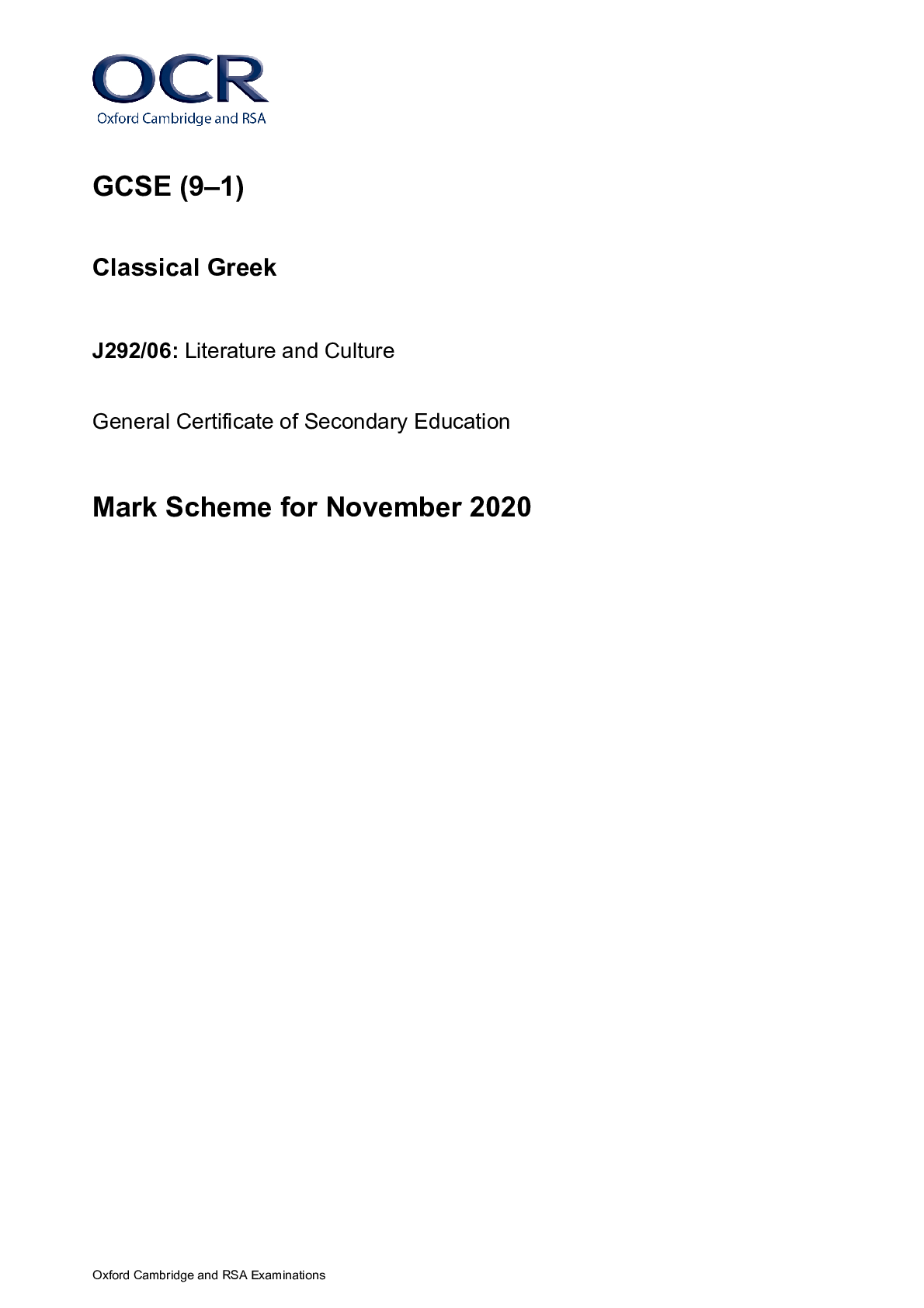
Buy this document to get the full access instantly
Instant Download Access after purchase
Add to cartInstant download
Reviews( 0 )
Document information
Connected school, study & course
About the document
Uploaded On
Oct 07, 2022
Number of pages
20
Written in
Additional information
This document has been written for:
Uploaded
Oct 07, 2022
Downloads
0
Views
56






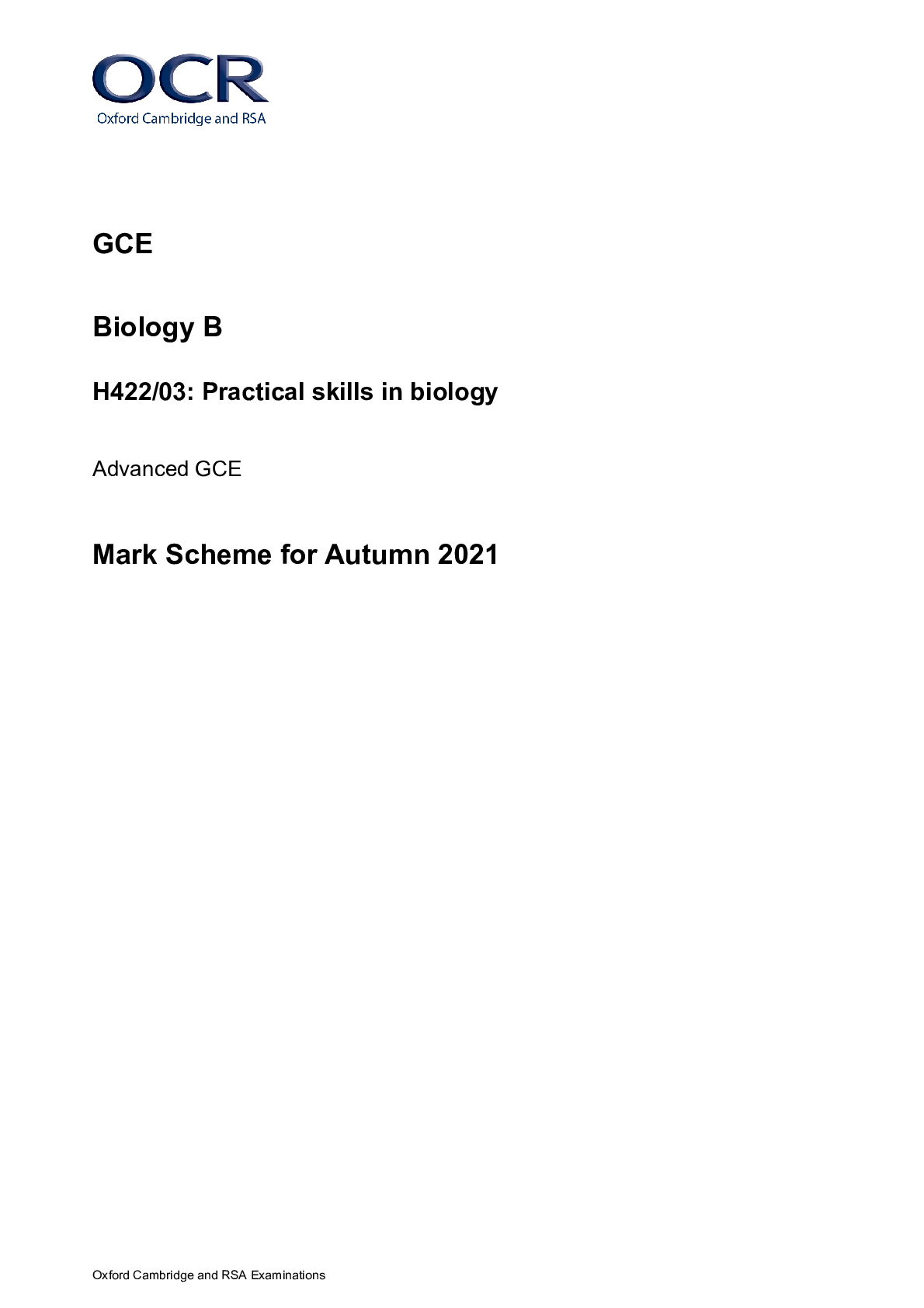


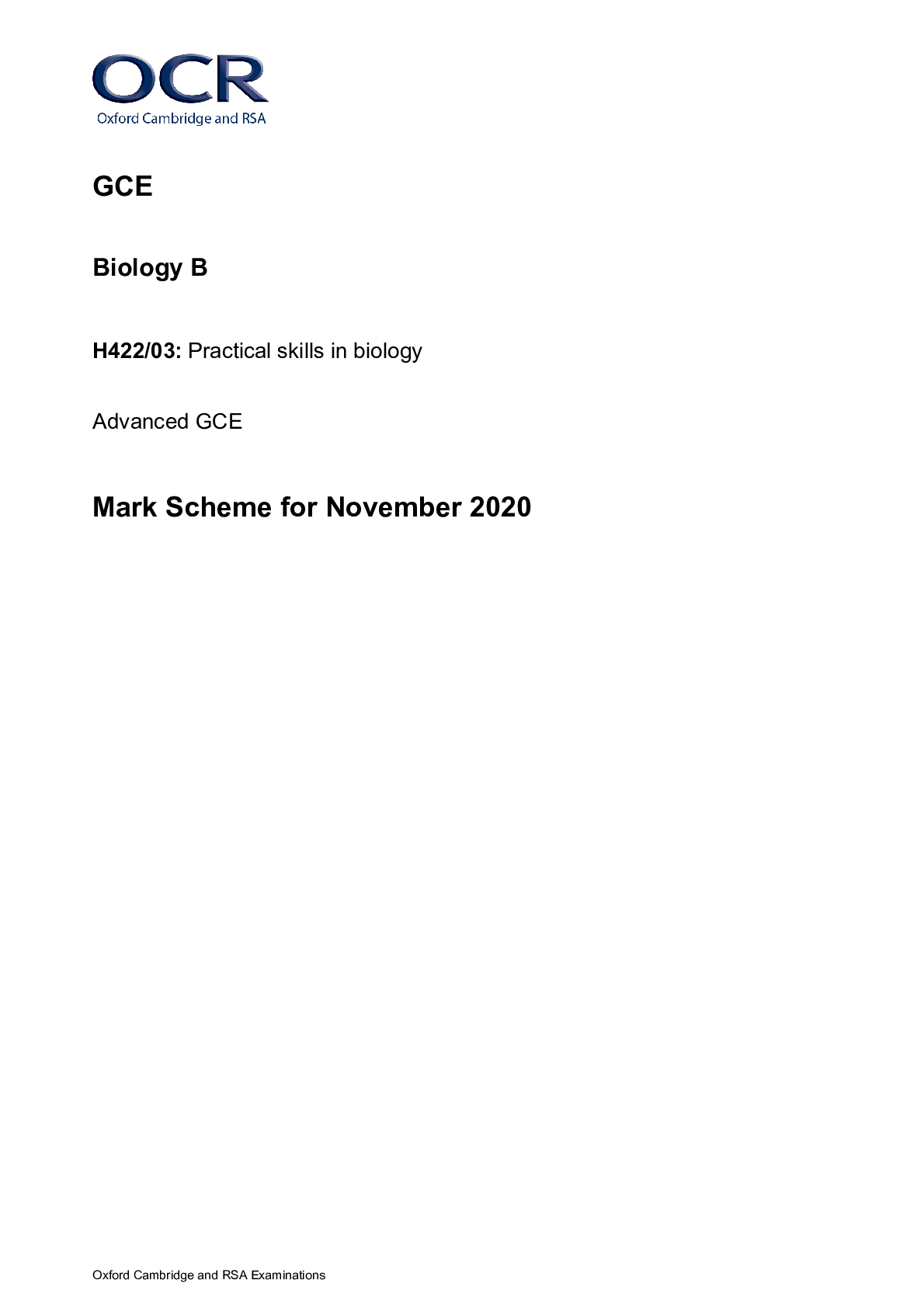
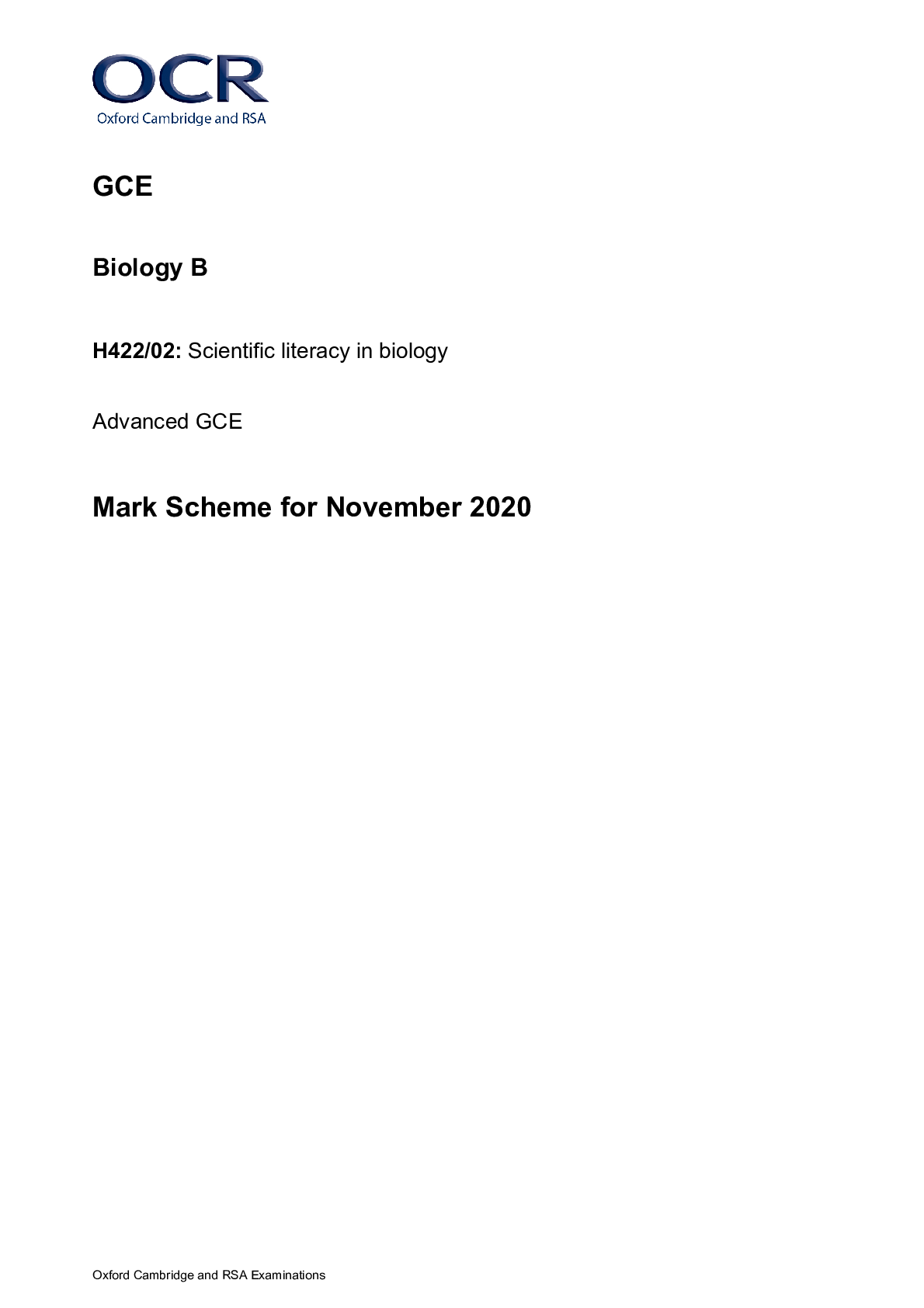
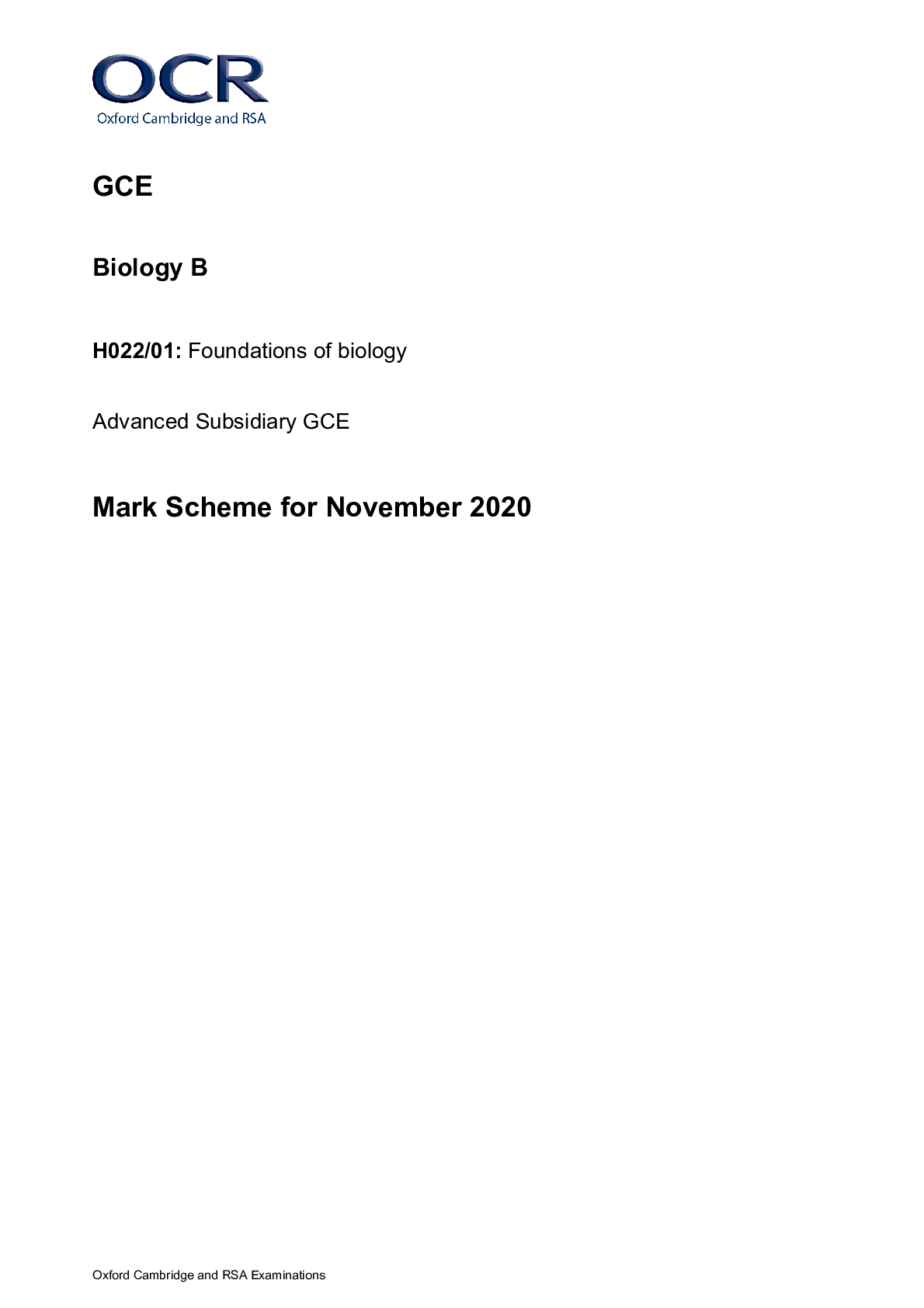




.png)
